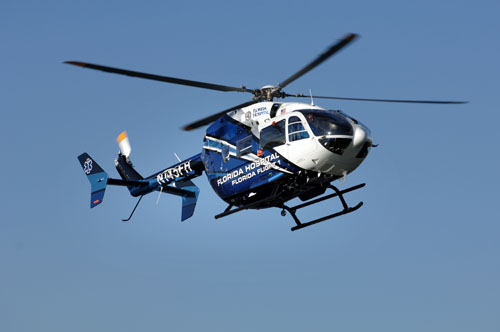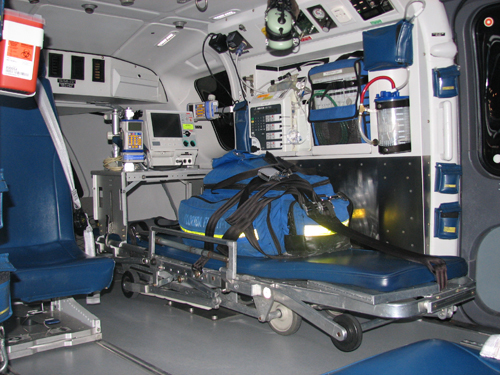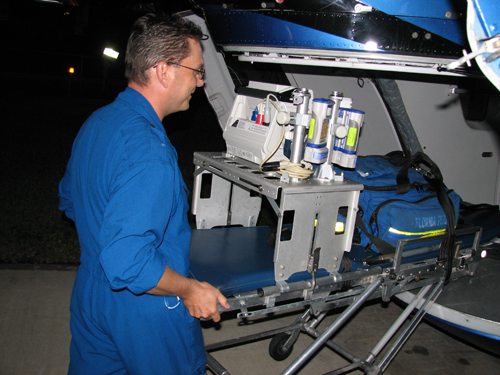Patient Safety on the Fly
July / August 2010
Patient Safety on the Fly Technology and Teamwork

Picture this: You are a nurse on an emergency transport helicopter en route to pick up a critical patient who is intubated at an outlying facility. Upon arrival, you learn the patient has adult respiratory distress syndrome (ARDS), complicated by septic shock. The patient’s blood pressure is in the low 70s, and he is on two vasopressors. He has been sedated, but not enough. He is visibly agitated and physically shaking. There are nine infusion pumps on three IV poles, in addition to other equipment in the room. All in all, his condition requires 12 intravenous (IV) infusions, and it’s your job to keep him stable until the helicopter reaches the hospital.
Providing care in a helicopter presents challenges that are different from providing care in a hospital. After nearly 5 years as a flight nurse, I’ve found that in order to meet the safety needs for in-flight care and to ensure patient safety, medical equipment used for air transport needs to be:
- Consistently reliable in the face of limited resources;
- Designed for a small, in-motion workspace; and
- Versatile enough to provide extended care during travel delays.
Safety Is Paramount
Every flight nurse quickly learns that safety is paramount. At Florida Hospital, our Florida Flight One medical helicopter provides an emergency room/critical care setting staffed by highly trained and qualified teams. But unlike a hospital emergency room, if something goes wrong, there is only one back-up for each medical device and no code button a nurse can hit to have hospital staff come running to help. Besides the patient, there are just three people onboard: a nurse, a pilot, and a respiratory therapist or critical care paramedic. The first safety measure for any flight occurs even before a patient is picked up —i f any of the three crew members do not feel right about the flight due to concerns about adverse weather conditions, the team does not go. If one person becomes concerned mid-flight, the helicopter turns around, and the flight is aborted. It’s an unwritten policy we call, “It takes three to go and one to say no.”
As a matter of course, every piece of equipment — from the IV bags to the helicopter itself — needs to be 100% reliable. We diligently seek out the highest quality, most durable equipment. Each piece of equipment must be “user-friendly.” If any of our equipment does not perform at 100%, for any reason, it is immediately sent out for service and replaced with a back-up device that either meets or exceeds those standards. There is no time to risk a malfunction or even a shortcoming. For instance, one of the most essential medical devices for any flight or critical care transport team is an infusion pump because the vast majority of patients requiring transport must have a continuous supply of IV medications and fluids. On average, patients who are flown require one or two infusions. However, flight teams must be immediately prepared to keep the patient stable and safe when surprises occur, like the aborted flight I described above. The most effective infusion pumps for use in-flight are not only reliable, but also are designed to accommodate multiple infusions, since space for additional pumps and equipment is limited.

Figure 1. Inside the helicopter cabin, the flight crew is prepared with ambulatory pumps and monitors to help keep the patient stabilized during flight. All tools used in the helicopter must be durable and adaptable to withstand the moving environment and must be compact and lightweight to fit within space constraints.
Courtesy of Ryan Dale
Florida Flight One averages 90 to 95 flights per month. As facilitator of our flight team’s quality assurance process, I thoroughly review each transport after the routine chart review has been performed. The details that are reviewed include the patient’s diagnosis, acuity, medications, and equipment used during the flight, as well as decisions that impacted the patient’s care (and their respective outcomes) during transport. Should questions arise, the case is reviewed for additional factors that may have had an impact on the patient’s care. The case is then re-evaluated to determine the level of impact those decisions had and whether any learning opportunities were present. One consistent finding throughout our quality assurance process is that having high-quality, technologically advanced equipment provides our flight crews with reliability and flexibility in critical situations.
Like Working Underneath a Kitchen Table
The typical workspace inside a helicopter is tight and volatile — comparable to working under a kitchen table that moves and turns. Within this space, the patient is lying on a stretcher with the flight team typically positioned at the patient’s head and side. It goes without saying that compact equipment is needed. However, even as everyday technology like computers and music players get smaller and smaller, bulky equipment and medical devices still take up precious space on emergency helicopters.
Standard equipment for hospitals doesn’t always make sense in-flight. When a helicopter encounters turbulence or other unforeseen obstacles, equipment that is not appropriately secured can move around unexpectedly and dangerously. Devices can shake loose, potentially interrupting the flow of medication to a patient. Worse, some devices could become dangerous projectiles and seriously injure a patient or crew member. The patients we transport by air typically require a higher level of care, and their conditions can change quickly. If a patient begins to deteriorate during flight, the flight team needs to be able to respond just as quickly — without unnecessary concerns about safety. Equipment that can be safely secured is of the utmost priority.
Just as our flight crews must work together seamlessly for patient care, we also must work together to prevent equipment from posing additional safety hazards. Because each flight team works differently, we use a pump that can be mounted either standing upright or on its side, enabling each flight team to customize it for the way they work best. To take full advantage of these options, while still ensuring the device is secure during flight, we had a custom mounting bracket made that enables the pump to be mounted to any of our three IV poles.

Ten Minutes… or an Hour
While our average flight lasts 10 minutes or less, some can take up to an hour, not counting delays or other unforeseen circumstances. If the patient is being flown in by fixed-wing airplane, it can take up to several hours. The same can be true in an ambulance. The reality of transporting patients means delays will arise, lengthening the amount of time that any type of transport team must be able to care for a patient.
When a helicopter or other transport is delayed or redirected, the risk of the patient deteriorating increases. The patient may require defibrillation, intubation, IV fluid boluses or more. All of the necessary equipment needs to be functional enough to go the distance. For instance, there can be a serious risk of infusion pumps running out of a medication that is critical for the patient. Having to refill an infusion during transport can lead to patient instability and may have a negative impact on the patient’s overall safety and condition.
Time is critical. Most infusion pumps can take several minutes to initiate or even refill. To minimize risk, our team uses a pump that can be connected directly to an existing IV infusion and has “easy to program” capabilities so that a weight-based infusion can be initiated, start to finish, in less than two minutes.
Prioritizing Made Simple
Remember the ARDS patient who needed 12 infusions? Had we been in a hospital, we would have had all the technology needed to give him the necessary drugs and keep him stable. But with limited options on a helicopter, the key is to prioritize. Therefore, we put the most important drugs on the most reliable pumps with the largest capacity.
The best healthcare technology — in-flight or otherwise — makes prioritizing simple. We work very hard to ensure we are using the absolute best technology available to suit our in-flight needs.
Ryan Dale is a flight nurse for Florida Hospital in Orlando. Before becoming a flight nurse, he spent 10 years as a critical care nurse. He may be contacted at ryan.dale@flhosp.org.
Technology Overview
Florida Flight One uses Hospira specialty infusion pumps.
